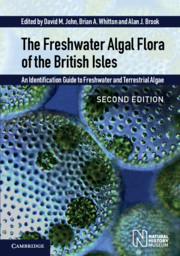 The Freshwater Algal Flora of the British Isles
The Freshwater Algal Flora of the British Isles Book contents
- Frontmatter
- Contents
- The online material (formerly provided in DVD format)
- List of Contributors
- Foreword
- Preface
- Acknowledgements
- Introduction
- Distribution and Ecology
- History of Freshwater Algal Studies in the British Isles
- Field Methods
- Laboratory Methods
- Water Framework Directive
- Cultures of British Freshwater Algae
- Classification
- Key to phyla
- Cyanobacteria (Cyanophyta)
- Phylum Rhodophyta (Red Algae)
- Phylum Euglenophyta (Euglenoids)
- Phylum Cryptophyta (Cryptomonads)
- Phylum Dinophyta (Dinoflagellates)
- Phylum Raphidophyta
- Phylum Haptophyta (Prymnesiophyta)
- Phylum Chrysophyta (Golden Algae)
- Phylum Xanthophyta (Tribophyta) (Yellow-Green Algae)
- Phylum Eustigmatophyta
- Phylum Bacillariophyta (Diatoms)
- Phylum Phaeophyta (Brown Algae)
- Primitive Green Algae (‘PRASINOPHYTA’)
- Phylum Chlorophyta (Green Algae)
- Phylum Glaucophyta
- Glossary
- Standard Form of Authors of Algal Names
- Sources of Illustrations or Material
- References
- Taxonomic Index
- Subject Index
- Plate Saction
- Miscellaneous Endmatter
- Miscellaneous Endmatter
Phylum Glaucophyta
Published online by Cambridge University Press: 12 January 2024
- Frontmatter
- Contents
- The online material (formerly provided in DVD format)
- List of Contributors
- Foreword
- Preface
- Acknowledgements
- Introduction
- Distribution and Ecology
- History of Freshwater Algal Studies in the British Isles
- Field Methods
- Laboratory Methods
- Water Framework Directive
- Cultures of British Freshwater Algae
- Classification
- Key to phyla
- Cyanobacteria (Cyanophyta)
- Phylum Rhodophyta (Red Algae)
- Phylum Euglenophyta (Euglenoids)
- Phylum Cryptophyta (Cryptomonads)
- Phylum Dinophyta (Dinoflagellates)
- Phylum Raphidophyta
- Phylum Haptophyta (Prymnesiophyta)
- Phylum Chrysophyta (Golden Algae)
- Phylum Xanthophyta (Tribophyta) (Yellow-Green Algae)
- Phylum Eustigmatophyta
- Phylum Bacillariophyta (Diatoms)
- Phylum Phaeophyta (Brown Algae)
- Primitive Green Algae (‘PRASINOPHYTA’)
- Phylum Chlorophyta (Green Algae)
- Phylum Glaucophyta
- Glossary
- Standard Form of Authors of Algal Names
- Sources of Illustrations or Material
- References
- Taxonomic Index
- Subject Index
- Plate Saction
- Miscellaneous Endmatter
- Miscellaneous Endmatter
Summary
This phylum was established to accommodate those algae with intracellular blue-green coloured cyanelles rather than chloroplasts, but where the main part of the cell cannot be assigned easily to another phylum such as the diatoms. Cyanelles are evolutionary steps between blue-green algae and chloroplasts, though are more like the latter than the former; they cannot exist independently of the host cell. The cyanelles of some genera have been treated as separate species, with their own Latin name, but as they cannot exist independently of the host cell, this is a doubtful practice. There is no reason to believe that the various types of host cell are closely related to each other. The phylum is therefore probably artificial. Ideally, organisms with cyanelles should be placed in the phylum which the host cell most closely resembles. However, the phylogenetic relationships of the genera Cyanophora, Glaucocystis and Gloeochaete are still unclear, so the phylum is retained for the time being. However, ribosomal RNA sequences indicate that the cyanelles of these three organisms do show considerable similarity (Helmchen et al., 1995). These authors also showed that the cyanelles of another cyanelle-containing organism, Glaucosphaera vacuolata (not recorded from British Isles), indicate that this belongs to the Rhodophyta.
Gloeochaete was included in the green algal order Tetrasporales in the 2002 Flora and 2003 Coded List and its coded number is retained here in the hope that the taxonomic relationships of these organisms will soon be resolved, so it seems unnecessary to make the change now. It is listed in the Glaucophyta here, as was suggested originally by Kies (1976).
1 Cells motile with 2 unequal flagella emerging from a subapical depression…………….Cyanophora
1 Cells non-motile……………………………………………. 2
2 Cells ellipsoid; cyanelles twisted around each other and typically 8 towards each end; reproduce by autospores ………………………………..Glaucocystis
2 Cells spherical; cyanelles usually ovoid or sausageshaped and lying in a cup-shaped region; reproduce by biflagellate zoospores ………………..Gloeochaete
Cyanophora Korshikov 1924
05050000
Cells flattened, ellipsoid, possessing 2 unequal flagella emerging from a subapical depression. One to 2 (when mature) cyanelles per cell. Reproduction by longitudinal division into 2 daughter cells each with a cyanelle.
Three known species.
Cyanophora paradoxa Korshikov 1924
05050010 Pl. 71H (p. 278)
Cells 2–3 μm thick, 5–8 μm wide, 8–12 μm long; 1–2 blue cyanelles.
Plankton of shallow lakes with hard, nutrient-rich water.
- Type
- Chapter
- Information
- The Freshwater Algal Flora of the British IslesAn Identification Guide to Freshwater and Terrestrial Algae, pp. 766 - 767Publisher: Cambridge University PressPrint publication year: 2021


